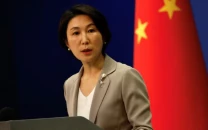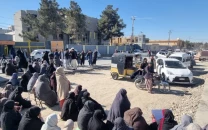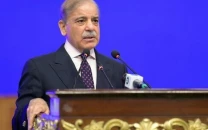Circular reasoning: NESPAK report green lights own proposed violations
Environmental impact assessment done after SC suo motu; document allegedly prepared in a day and backdated.

The launch of the Metro Bus system in Lahore. PHOTO: AFP
After its initial reluctance to approve the metro bus project, the Capital Development Authority is in the awkward position of having to defend it in front of the Supreme Court of Pakistan today (Tuesday) . The destruction of green belts in Islamabad to make way for dedicated roads for the project is the point of contention.
The authority’s reply, which will be submitted in court today, terms the green belt stretching over hundreds of acres along the 9th Avenue as “right of way” of the road, meaning it is reserved for further expansion of the existing road.
Meanwhile, a hurriedly-arranged Environment Impact Assessment report, prepared by project consultant Nespak, will also be submitted with the court.
Earlier, the Chief Justice of Pakistan took notice of the “flawed” route alignment of the Islamabad section of the project in a bid to avert possible threats to the environment.
The CJP had directed the CDA to submit detailed reports of the project by March 18. The reports were meant to show whether or not the project would pose a threat to the Islamabad’s green belts or otherwise violate its master plan. The CJP had also inquired about the EIA report.
The Executive Committee of the National Economic Council has already approved the project, subject to clearance of an EIA report.
A source at the CDA said the authority is of the view that the city’s master plan marks 300 feet on either sides of the existing 9th Avenue median for the road and the greenbelt. The greenbelt between 9th Avenue and the eight-series of sectors is 125 feet and meets the right of way requirements.
He said Nespak had already issued an EIA report to the CDA, which will in turn be given to the Pakistan Environmental Protection Agency for final approval. “After the Supreme Court took notice of the issue, Nespak managed to prepare a backdated EIA,” a source at Nespak confirmed.
He said report had been prepared by the Environment Wing of Nespak.
“Transparency requires hiring a firm of international repute for the [EIA], rather than Nespak, which is already a major stakeholder in the project,” said the official. He said Nespak had designed the whole project and will also be supervising the construction of the project,” the official said, while expressing a lack of surprise that the Nespak report is in favour of the project.
The official claimed that the CJP took notice on March 14, and Nespak officials managed to produce an EIA report issued on March 13.
Nespak’s project manager Danish Raza refused to comment on the issue, saying he was not authorized to talk to the media.
Nespak, the design consultant for metro bus project, has proposed the expansion of 9th Avenue and Jinnah Avenue by eliminating a green belt stretching over hundreds of acres east of the road --- formally named Agha Shahi Avenue --- and west of sectors I-8, H-8 and G-8, if the plan is approved.
According to the plan, the IJ Principal Road carriageway of 9th Avenue will be converted into a dedicated corridor for the metro bus, while an additional three lanes will be carved out from the green belt along 9th Avenue to accommodate traffic heading towards IJP Road from the Kashmir Highway.
In addition, Jinnah Avenue will be widened by six metres on both sides to create a dedicated corridor for the metro bus, but this expansion will also gobble up the emergency lanes on both sides of the avenue.
Published in The Express Tribune, March 18th, 2014.



















COMMENTS
Comments are moderated and generally will be posted if they are on-topic and not abusive.
For more information, please see our Comments FAQ